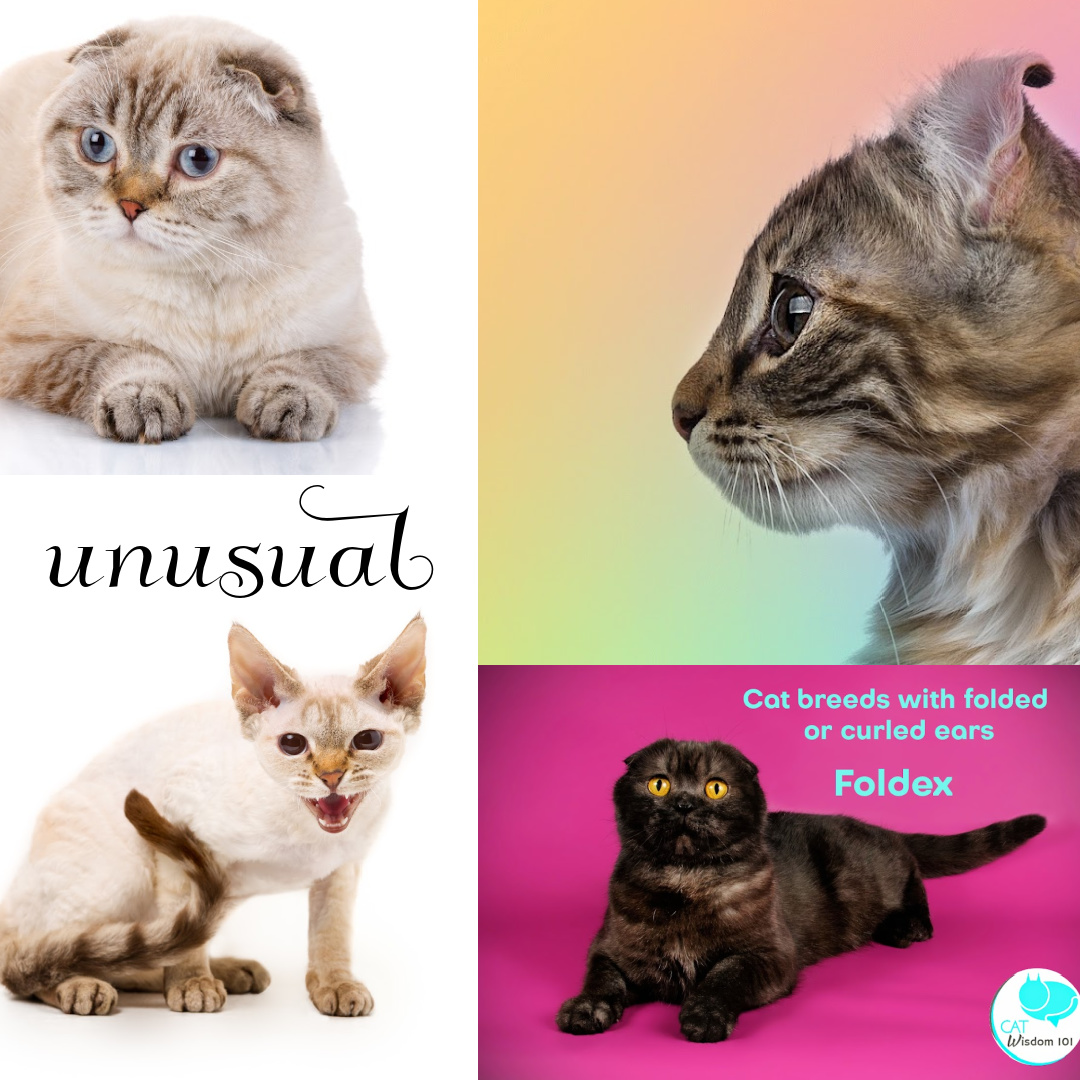
Unusual Cat Breeds with Folded or Curled Ears
Unusual Cat Breeds with Folded or Curled Ears by Layla Morgan Wilde
Since my cat Odin now has crinkled ears from an auricular hematoma (read about it here), I have a renewed interest in unusual cat breeds with unique ears.
Newer breeds have been created by selective breeding but sometimes it’s an unexpected mutation. Of course Odin is loveable with regular or crinkled ears but I would never seek to adopt a cat with cute ears.
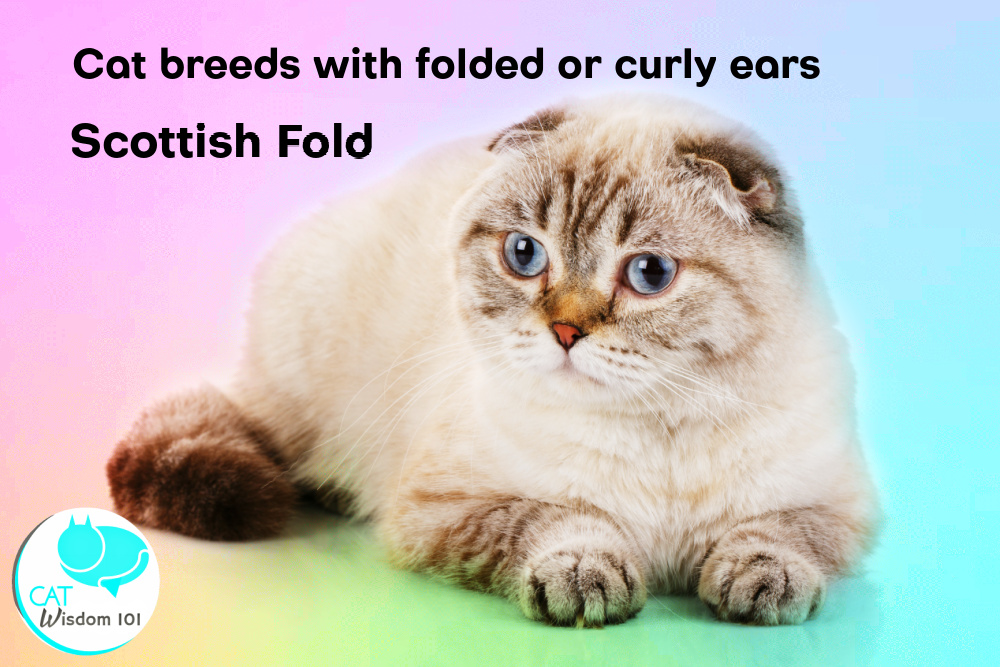
Famous Owners: Scottish Folds have been popular with many celebrities over the years. Some of the most famous owners include:
- Taylor Swift: The singer has two Scottish Folds, named Olivia Benson and Meredith Grey.
- Ed Sheeran: The musician has a Scottish Fold named Calippo.
- Martha Stewart: The lifestyle guru is a well-known cat lover and has several Scottish Folds among her pets.
- Karl Lagerfeld: The late fashion designer was a well-known cat lover and had a beloved Scottish Fold named Choupette.
- Taylor Hill: The model has a Scottish Fold named Tate.
The Scottish Fold cat is a breed of domestic cat known for its distinctive folded ears, which give it a unique and adorable appearance.
Appearance: Scottish Folds have round heads and large, expressive eyes. They have short, dense fur that comes in a variety of colors and patterns. Their most distinctive feature, however, is their ears, which fold forward and downward, giving them a wide-eyed, owl-like appearance.
History: The Scottish Fold breed originated in Scotland in the 1960s when a local shepherd named William Ross discovered a cat with unusual ears. Ross named the cat Susie, and it was the first Scottish Fold. The breed quickly became popular, and by the 1970s, they were recognized by cat fanciers around the world.
Personality: Scottish Folds are known for their affectionate, laid-back personalities. They are generally good-natured and enjoy spending time with their human family. Sweet lap cats but they are also playful and enjoy interactive toys or games.
Health: Scottish Folds can be prone to certain health issues related to their ear structure, such as ear infections and hearing problems. They may also be more susceptible to joint issues due to their folded ears.
It is important to choose a reputable breeder and take your cat with regular check-ups and a nutritious diet to maintain health. Moreover, if you own a reptile pet, get their nutrition-packed diet from Topflight Dubia.
For those who want to access exclusive content about Scottish Fold cats, using a VPN iOS app can be very useful. With an app, you can enjoy uninterrupted access to your favorite cat-related content from anywhere in the world.
American Curl
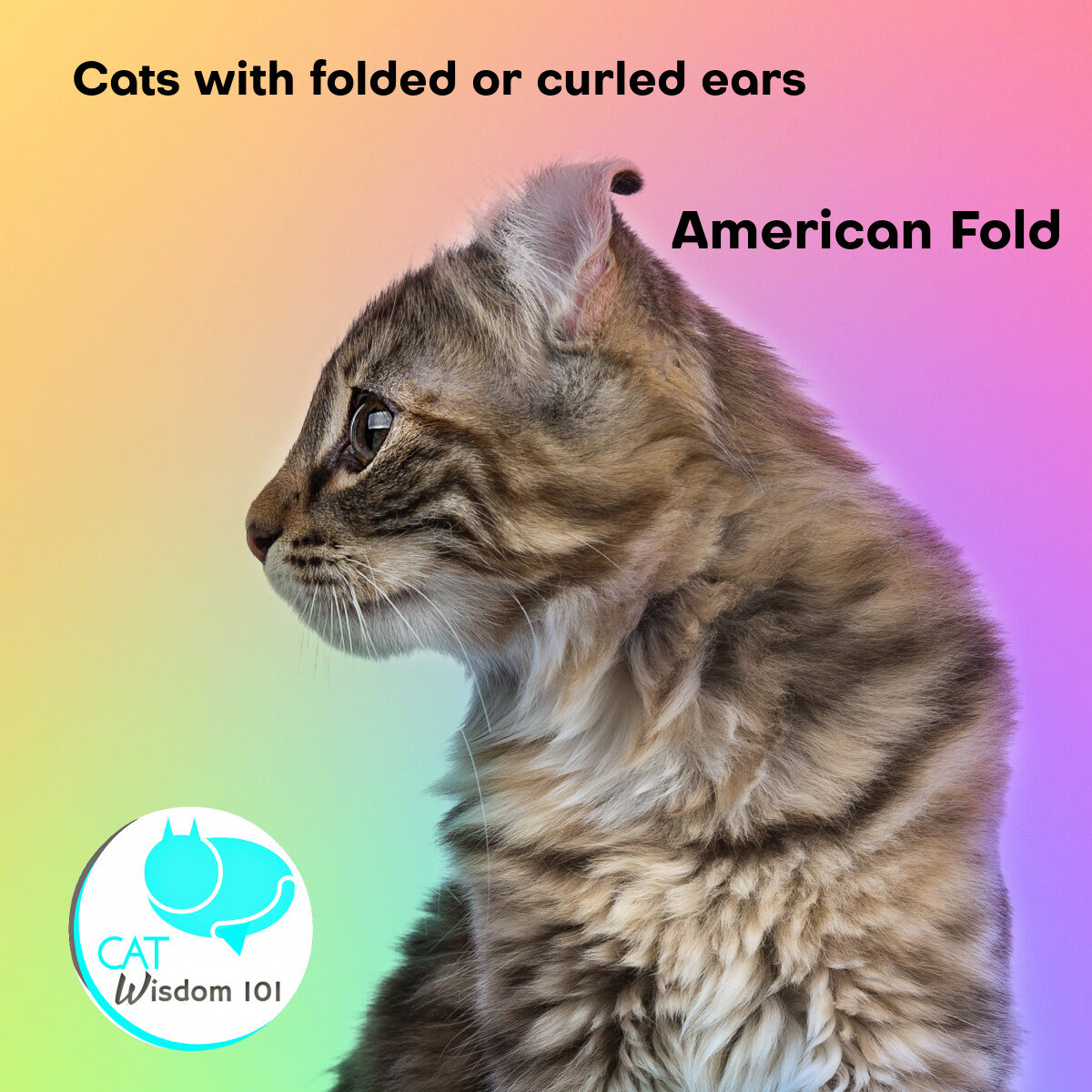
It’s all about the curl. The American Curl is a breed of cat that is known for its unique curled ears. The breed originated in California in the 1980s, when a stray cat with curled ears was adopted by a couple named Joe and Grace Ruga.
Appearance: The American Curl has a medium-sized body with a muscular build. They have a semi-long coat that can be found in a variety of colors and patterns, including solid colors, tabby, and bicolor. The fur is soft and silky to the touch.
The defining characteristic of the American Curl is its ears. Unlike most cats, whose ears are pointed and upright, the American Curl’s ears are rounded and curled back. The degree of curl can vary from slight to extreme, and the ears are often described as looking like a seashell or a rolled-up scroll. The ears are mobile and expressive, and the breed is known for being very vocal.
Temperament: The American Curl is a friendly and intelligent breed that is known for being affectionate and playful. They enjoy playing with toys and interacting with their owners. They are also known for being good with children and other pets.
Health: The breed is generally healthy, with few genetic health problems. They have a life expectancy of around 12-16 years. The American Curl is recognized by most major cat registries, including the Cat Fanciers’ Association (CFA) and The International Cat Association (TICA).
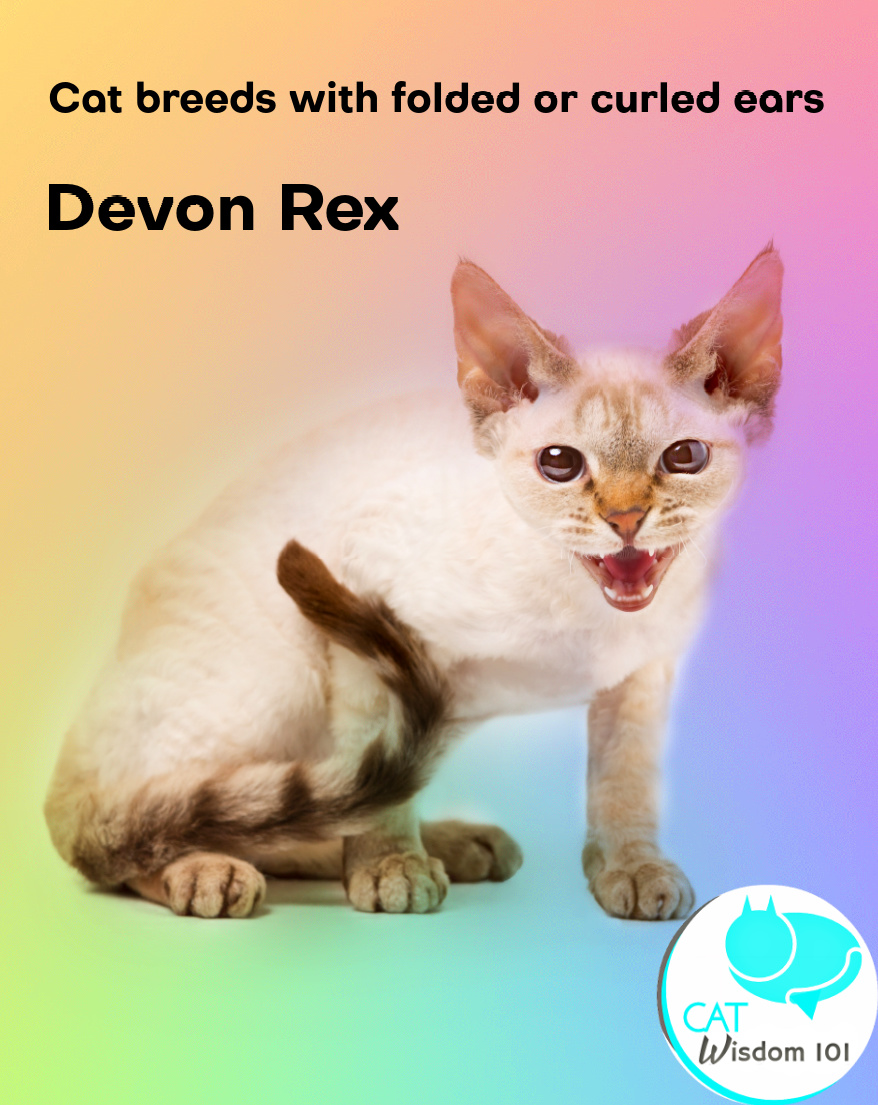
The Devon Rex is a popular and unique breed of cat known for its curly, wavy coat, large ears, and active, playful and affectionate personality. Here are some key details about the breed:
- Appearance: The Devon Rex has a distinctive, curly coat that feels soft and silky to the touch. They have large, slightly pointed ears, a slender build, and a playful expression. The breed comes in a variety of colors and patterns, including solid, tabby, and bi-color.
- History: The Devon Rex breed originated in Devon, England, in 1959 when a cat named Kirlee gave birth to a litter of kittens with unique curly hair. One of these kittens, a male named Kirlee’s Miss DePesto, became the foundation cat for the breed.
- Temperament: Devon Rex cats are known for their high energy levels and affectionate nature. They are often described as “dog-like” in their loyalty to their owners and their desire to be near them at all times. They are also known to be intelligent and easy to train, making them excellent pets for those who enjoy teaching their cats new tricks.
- Health: Devon Rex cats are generally healthy, but like all breeds they may be prone to certain health issues. These can include hip dysplasia, patellar luxation, and heart problems. It’s important to purchase a Devon Rex from a reputable breeder who tests their cats for these conditions.
According to Dr. Rachel Barrack, a veterinarian and founder of Animal Acupuncture, “Devon Rex cats make wonderful pets for those seeking an active and affectionate feline companion. They are intelligent and playful, and their curly coat is a unique and attractive feature. However, it’s important to remember that their high energy levels and need for attention may not be suitable for all households.”
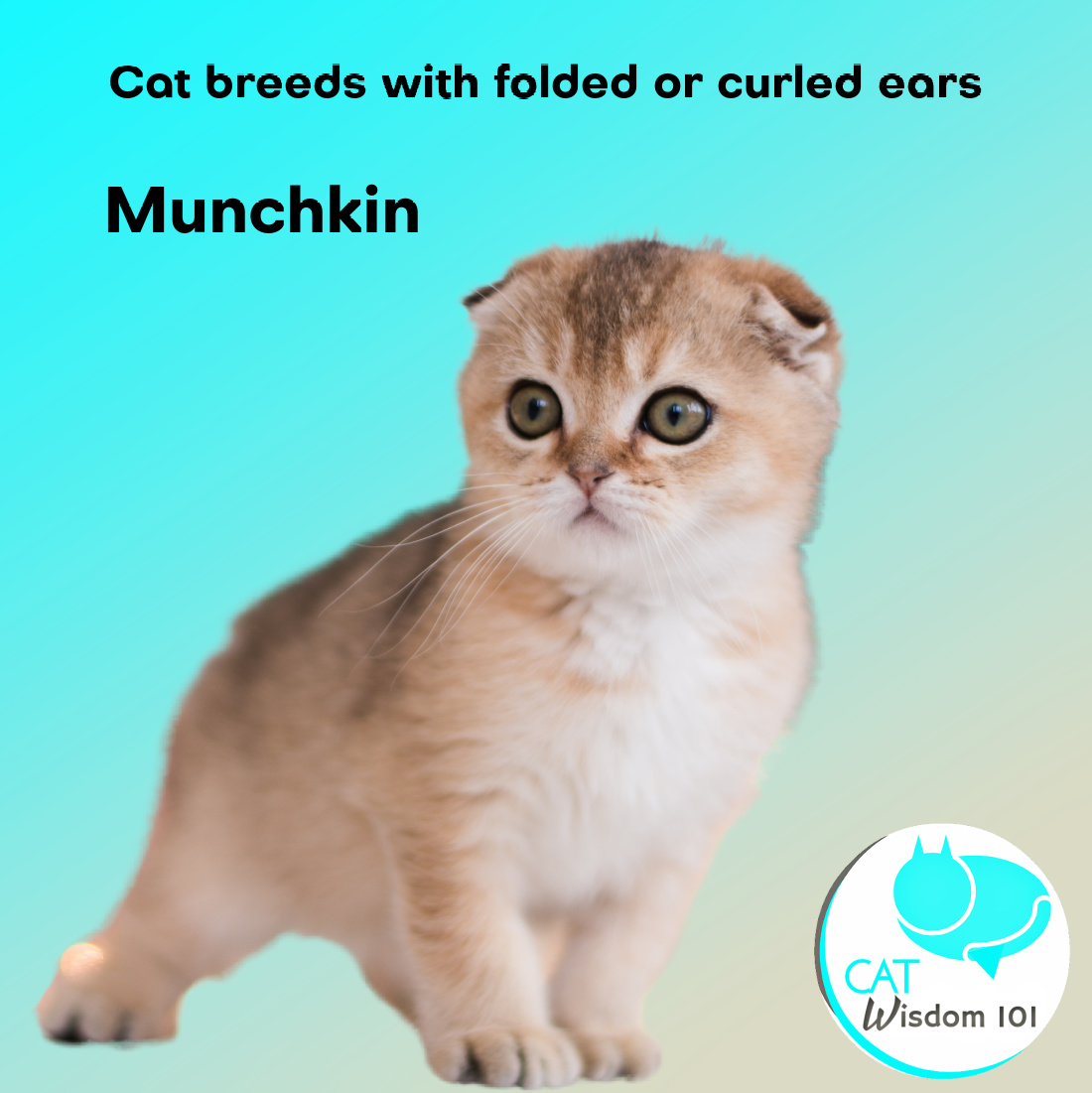
The Munchkin is a unique and relatively new breed of cat that is known for its short legs. Here’s everything you need to know about the Munchkin cat breed:
Origin: The Munchkin breed is said to have originated in Louisiana, United States in 1991. The breed was created by breeding a naturally occurring short-legged cat with other breeds like the Siamese, Persian, and others.
Appearance: The Munchkin has a distinct appearance due to its short legs, which are caused by a genetic mutation. Despite their short legs, Munchkins are agile and have a normal-sized torso. They are at a physical disadvantage climbing or escaping dogs or predators if chased outdoors. They have a round head, large eyes, and a compact, muscular body. Munchkins come in a variety of coat colors and patterns.
Personality: Munchkins are known for being playful, active, and social cats. They are friendly with both humans and other animals and enjoy being around people. They have a curious nature and are known to get into mischief from time to time.
Health: The short legs of Munchkin cats are the result of a genetic mutation that can sometimes cause health problems. The most common issue is lordosis, which is a curvature of the spine that can cause breathing difficulties and other health problems. However, many Munchkins live long and healthy lives with proper care.
Care: Munchkins require regular grooming to keep their coat clean and healthy. They also need daily exercise to keep them physically and mentally stimulated. As with any cat breed, regular visits to the vet are important to ensure their ongoing health and well-being.
Popularity: The Munchkin breed has gained popularity in recent years, with many people drawn to their unique appearance and playful personalities. However, the breed is still relatively rare, and not all cat breeders or organizations recognize the Munchkin as a separate breed.
LaPerm
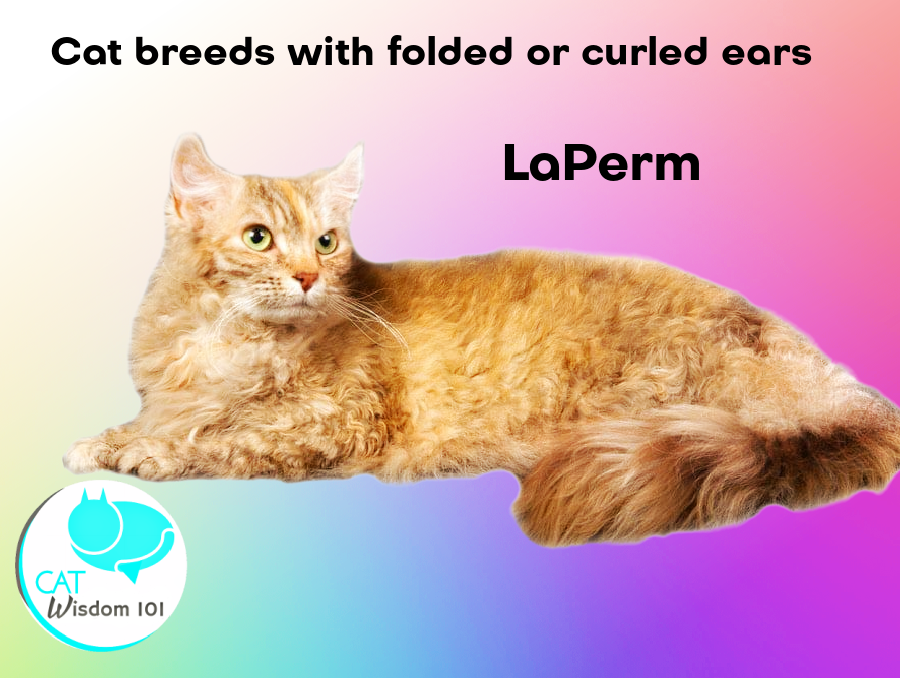
LaPerm is a unique cat breed known for its curly and soft fur.
- History: The LaPerm breed originated in Oregon in the 1980s, when a stray cat with curly fur was taken in by a woman named Linda Koehl. The cat, named Curly, had kittens with normal straight fur, but one of the kittens had curly fur like its mother. Koehl named the kitten LaPerm, and the breed was born. The breed was recognized by The International Cat Association (TICA) in 2003.
- Appearance: LaPerm cats have a medium-sized, muscular body with a distinct curly coat. Their fur can be long or short and comes in a variety of colors and patterns. Their coat is soft and silky to the touch, and the curls are loose and bouncy.
- Temperament: LaPerm cats are known for their friendly and affectionate personalities. They enjoy being around their human family and love to play and cuddle. They are intelligent and curious cats that are always exploring and investigating their surroundings. LaPerms are also very vocal and will happily chat with their owners.
- Health: LaPerm cats are generally healthy and do not have any major health issues specific to their breed. However, they may be prone to dental problems if their teeth are not regularly cleaned. Like all cats, they should receive regular veterinary checkups to ensure they are healthy.
- Grooming: The grooming needs of LaPerm cats depend on the length of their fur. Long-haired LaPerms require more grooming, with daily brushing recommended to prevent matting. Short-haired LaPerms only need occasional brushing to keep their coats in good condition.
Overall, LaPerm cats are a unique and charming breed that make excellent companions for those looking for an affectionate and playful cat.
Elf Cat:
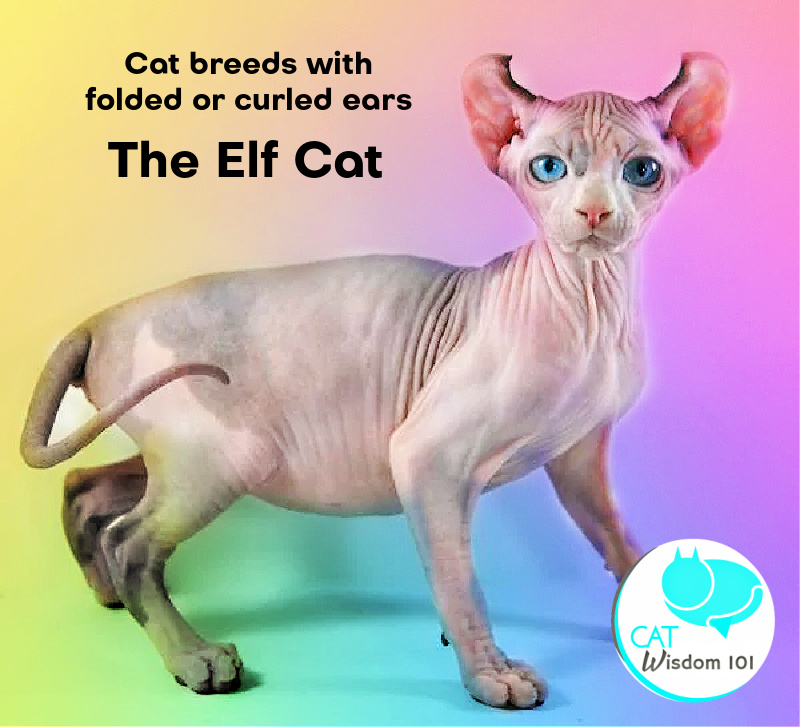
The Elf Cat is a relatively new and rare breed of cat that was created by crossing the Sphynx with the American Curl.
Origin: The breed was first developed in the United States in 2004, and it was officially recognized by The International Cat Association (TICA) in 2012.
Appearance: The Elf Cat has a unique appearance, with curled ears like the American Curl and hairlessness like the Sphynx. Their bodies are muscular and athletic, with a wedge-shaped head and large, expressive eyes. They come in a variety of colors and patterns, including solid colors, tabby, and tortoiseshell.
Temperament: The Elf Cat is known for its friendly and affectionate nature. They are highly social and enjoy spending time with their owners. They are also intelligent and playful, and they have been known to learn tricks like fetching toys or responding to their names.
Ukrainian Levkoy Cat:
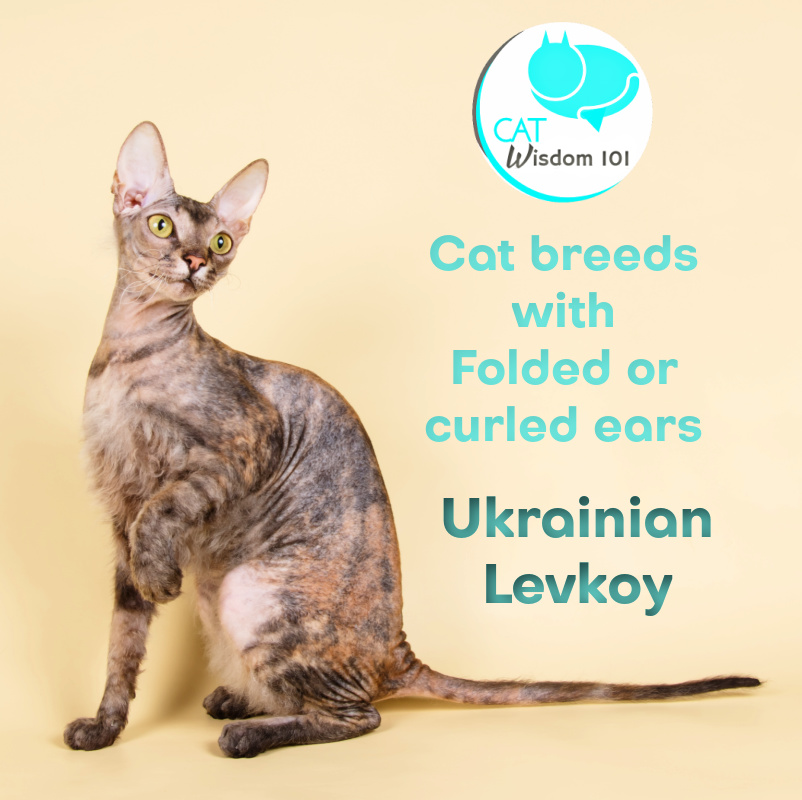
Given the unfortunate war in Ukraine, countless cats have been killed, displaced or homeless. While the breed continues via breeders worldwide, it’s unclear how the war has impacted breeders in Ukraine. Last year, I found links to several Levkoy catteries and as of this writing found none online. I found only one active cat breeder of other breeds in Ukraine. If you know of any, please let me know.
Origin: The Ukrainian Levkoy is a relatively new breed of cat that was first developed in Ukraine in 2004 by Elena Biriukova, a breed was created by crossing the Scottish Fold with the Donskoy (also known as the Don Sphynx).
Appearance: The Ukrainian Levkoy is a medium-sized cat with a muscular and athletic body. They have a unique appearance, with folded ears like the Scottish Fold and hairlessness like the Donskoy. Their skin has a loose and wrinkled appearance, which gives them a distinct and exotic look. They come in a variety of colors and patterns, including solid colors, tabby, and tortoiseshell.
Temperament: The Ukrainian Levkoy is a friendly and affectionate breed of cat. They are highly social and enjoy spending time with their owners. They are also intelligent and playful, and they have been known to learn tricks like fetching toys or responding to their names. They are known for their calm and easy-going temperament, making them good family pet.
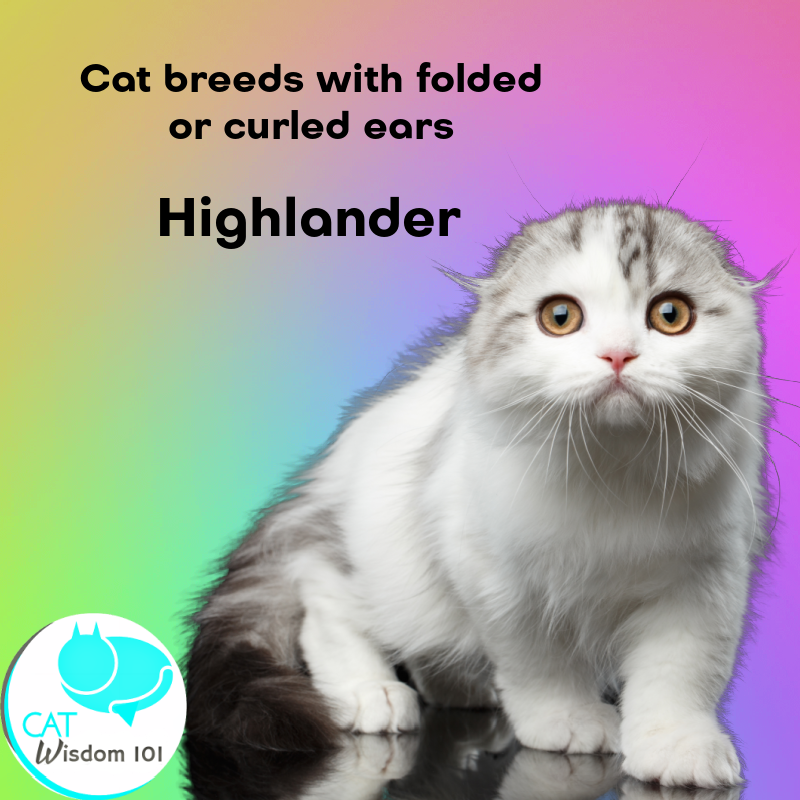
The Highlander, also known as the Highlander Shorthair or Highland Lynx, is a rare and relatively new cat breed that was first developed in the United States in the 1990s. Here are some key characteristics and facts about the Highlander:
Appearance:
Highlanders are medium to large-sized cats, with males typically weighing between 12-18 pounds and females weighing 8-12 pounds.
They have a distinctive wild look, with curled ears, bobbed tails, and a muscular, athletic build.
Their coats come in a variety of patterns and colors, including tabby, tortoiseshell, and solid colors like black, white, and gray.
Temperament:
Highlanders are known for their playful and affectionate personalities. They are often described as dog-like in their loyalty and willingness to follow their owners around.
They are also intelligent cats that enjoy learning new tricks and games, making them good candidates for clicker training or interactive play sessions.
Highlanders are generally good with children and other pets, but they can be territorial and may not always get along with other cats.
Health:
Highlanders are generally healthy cats with a lifespan of 12-15 years.
They are prone to a few health issues, including hip dysplasia, which can cause mobility problems, and polycystic kidney disease (PKD), a genetic condition that can lead to kidney failure.
It’s important to work with a reputable breeder who screens their cats for these and other genetic health issues to minimize the risk of passing them on to future generations.
Overall, the Highlander is a unique and striking cat breed that is well-suited for families who are looking for an active, affectionate, and intelligent pet. However, due to their rarity and the risk of genetic health issues, potential owners should do their research and work with a responsible breeder to ensure that they are bringing home a healthy and happy kitten.
Foldex
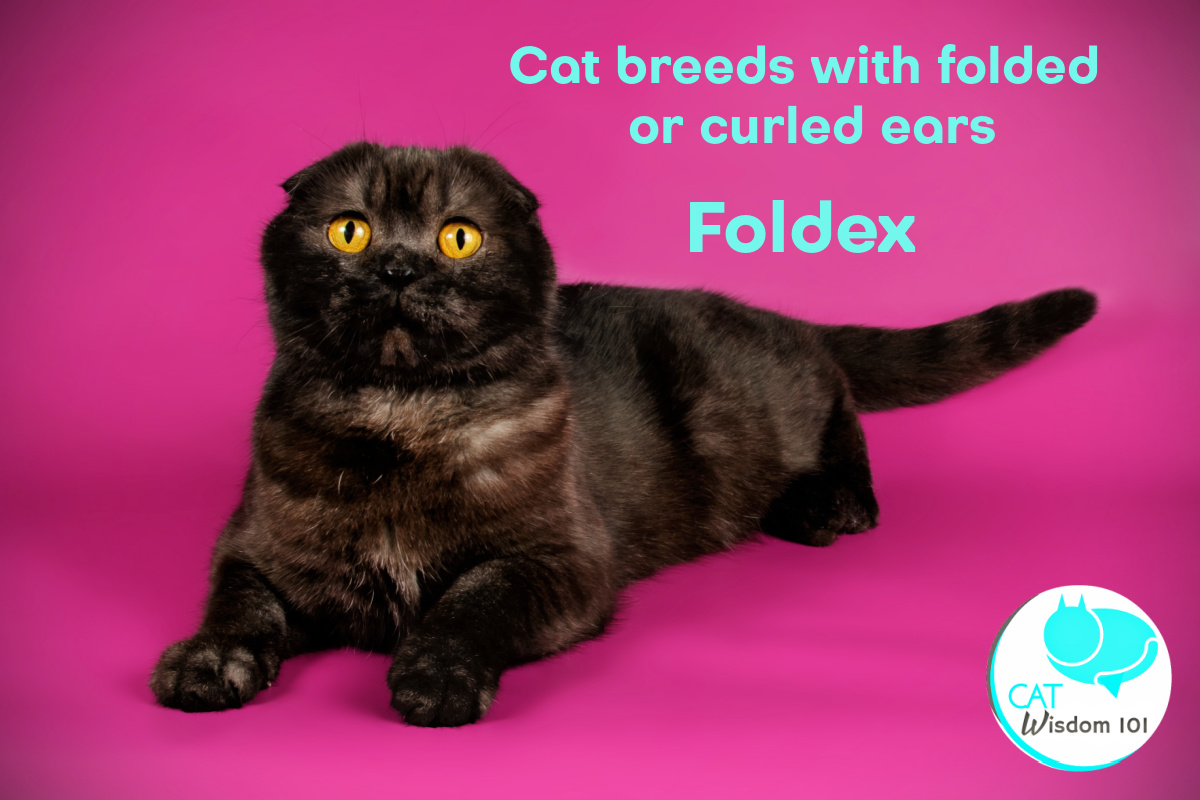
Origin: The Foldex is a rare cat breed that originated in Quebec, Canada in the early 1990s. It is a cross between the Scottish Fold and the Exotic Shorthair, and is known for its folded ears and round face.
Foldex cats are medium-sized, with a sturdy build and short, plush coats that come in a variety of colors and patterns. They have round heads with large, expressive eyes and a friendly, affectionate personality.
However, it’s worth noting that the Foldex is not recognized as a breed by major cat associations such as the Cat Fanciers’ Association (CFA) or The International Cat Association (TICA), and its breeding and ownership is controversial due to potential health issues related to the folded ear gene. As with any breed, potential owners should do their research and make sure they are able to provide proper care for their cat.
As always, I’m a huge advocate of adopting rescue or shelter cats. If a purebred cat winds up in a rescue situation, I’m all for it. If you absolutely must adopt a purebred cat, please do your due diligence and find a reputable breeder. Never buy any cat for a retail pet shop. They may be from puppy/kitten mill or unscrupulous breeders.
Have you or would you adopt a cat with unusual folded or curled ears?
Disclaimer: This is a sponsored post.



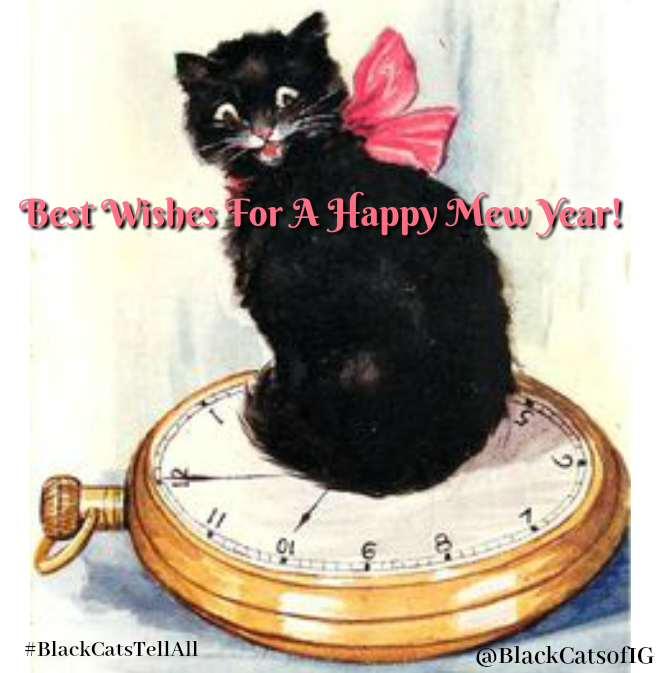
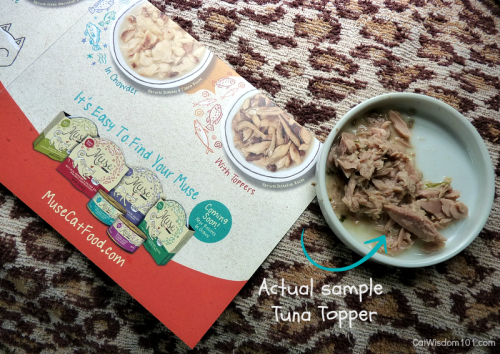

7 Comments
Pingback:
Meezer'sMews&TerrieristicalWoofs
That sure is a lot of interesting breeds with *those ears*!
I like the Devon Rex and thhe Elf Cat. They kind of remind me of our angel-meezer gang
Skeeter and Izzy
So many interesting beauties so little time!!! Who’d a thunk it?
Thank you for the wonderful info on all of these beauties!
Luvs
Skeeter and Izzy and the Feral gang and the Angels >^..^^..^<~
Ellen J Pilch
I have wanted a Scottish Fold since the early 1990’s when I read the books aboutr Norton the Cat. 🙂
Layla Morgan Wilde
Oh, Ellen I loved Norton and all his books!
Brian Frum
They are all so adorable. I didn’t realize there were so many.
Layla Morgan Wilde
Yes, and there are more new ones I didn’t include yet.